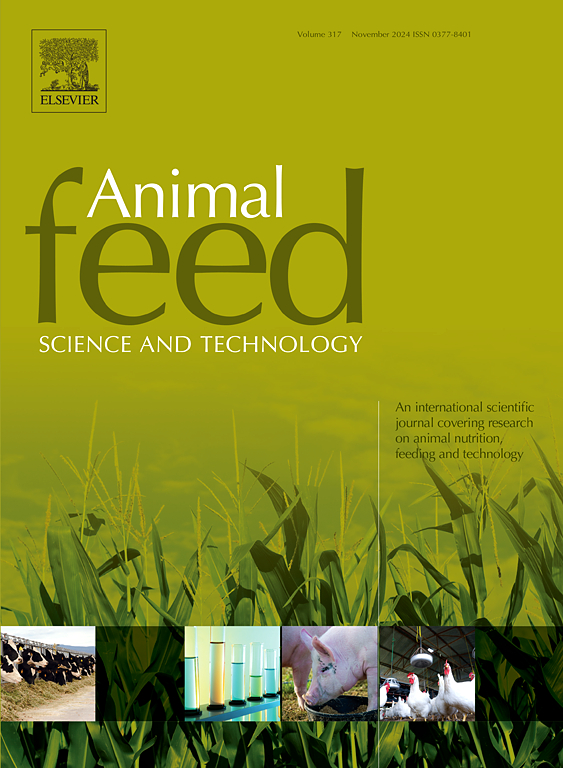Effects of dietary lipid levels on the growth, health, gut microbiota composition and lipid metabolism of juvenile Spinibarbus caldwelli
IF 2.7
2区 农林科学
Q1 AGRICULTURE, DAIRY & ANIMAL SCIENCE
引用次数: 0
Abstract
This study aimed to determine the optimal dietary lipid requirement and assess gut microbiota composition in juvenile Spinibarbus caldwelli. Five iso-nitrogenous diets containing graded lipid levels (L1: 2.29 %, L2: 4.54 %, L3: 6.35 %, L4: 8.07 %, L5: 10.04 %) were formulated and fed to S. caldwelli (initial body weight: 2.70 ± 0.01 g) for 56 days. A total of 450 fish were randomly allocated into 15 tanks (3 replicates per group, 30 fish per tank). The results revealed that: 1) Although no significant differences (P > 0.05) were observed in WG, SGR, and SR, these parameters exhibited a declining trend with increasing dietary lipid levels. 2) Muscle crude protein content in the L2 group was significantly higher than that in other groups (P < 0.05), accompanied by distinct variations in lipid and moisture contents. 3) The L2 group displayed markedly elevated concentrations of SFAs and PUFAs in muscle tissue compared to other dietary treatments (P < 0.05). 4) Hepatic and intestinal enzyme activities were significantly enhanced in the L2 and L3 groups (P < 0.05), with optimal performance observed at moderate lipid levels. 5) Intestinal microbiota analysis indicated that the L2 group exhibited significantly higher Shannon, Pielou E, and Simpson indices than other groups (P < 0.05). In conclusion, the L2 group demonstrated superior hepatic antioxidant capacity, enhanced intestinal digestive and lipid metabolic enzyme activities (P < 0.05), and a more diverse and abundant gut microbial community. The analysis results suggested that a 4.54 % dietary lipid level is optimal for juvenile S. caldwelli under the experimental conditions, providing critical insights for formulating species-specific aquafeeds.
饲料脂肪水平对caldhinbarus幼鱼生长、健康、肠道菌群组成和脂质代谢的影响
本研究旨在确定caldhinbarbus幼鱼的最佳饲料脂质需要量并评估肠道微生物群组成。配制5种不同脂质水平的等氮饲粮(L1: 2.29 %,L2: 4.54 %,L3: 6.35 %,L4: 8.07 %,L5: 10.04 %),饲喂初始体重为2.70 ± 0.01 g的caldwelli 56 d。试验选取450尾鱼,随机分为15个鱼缸(每组3个重复,每个鱼缸30尾鱼)。结果表明:1)随着饲粮脂质水平的升高,增重、SGR和SR虽无显著差异(P >; 0.05),但均呈下降趋势。2) L2组肌肉粗蛋白质含量显著高于其他各组(P <; 0.05),脂肪和水分含量变化显著。3)与其他饲粮处理相比,L2组肌肉组织中sfa和PUFAs浓度显著升高(P <; 0.05)。4) L2和L3组肝脏和肠道酶活性显著提高(P <; 0.05),在中等脂肪水平时表现最佳。5)肠道菌群分析显示,L2组Shannon、Pielou E和Simpson指数显著高于其他各组(P <; 0.05)。综上所述,L2组肝脏抗氧化能力更强,肠道消化和脂质代谢酶活性增强(P <; 0.05),肠道微生物群落更加多样化和丰富。分析结果表明,在实验条件下,4.54 %的饲料脂质水平是caldwelli幼鱼的最佳饲料水平,这为制定特定种类的水产饲料提供了重要的见解。
本文章由计算机程序翻译,如有差异,请以英文原文为准。
求助全文
约1分钟内获得全文
求助全文
来源期刊

Animal Feed Science and Technology
农林科学-奶制品与动物科学
CiteScore
6.00
自引率
6.20%
发文量
266
审稿时长
3 months
期刊介绍:
Animal Feed Science and Technology is a unique journal publishing scientific papers of international interest focusing on animal feeds and their feeding.
Papers describing research on feed for ruminants and non-ruminants, including poultry, horses, companion animals and aquatic animals, are welcome.
The journal covers the following areas:
Nutritive value of feeds (e.g., assessment, improvement)
Methods of conserving and processing feeds that affect their nutritional value
Agronomic and climatic factors influencing the nutritive value of feeds
Utilization of feeds and the improvement of such
Metabolic, production, reproduction and health responses, as well as potential environmental impacts, of diet inputs and feed technologies (e.g., feeds, feed additives, feed components, mycotoxins)
Mathematical models relating directly to animal-feed interactions
Analytical and experimental methods for feed evaluation
Environmental impacts of feed technologies in animal production.
 求助内容:
求助内容: 应助结果提醒方式:
应助结果提醒方式:


